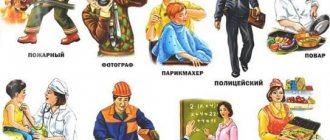“Formation of the fundamentals of life safety among pupils”
“The most precious thing a person has is life” N. A. Ostrovsky.
Forming the foundations for the safety and life of children in the context of preschool education is an urgent and significant problem, since it is determined by the objective need to inform children about the rules of safe behavior, and for them to gain experience of safe behavior in everyday life.
It is important not only to protect the child from danger, but also to prepare him to face possible difficulties, to form an understanding of the most dangerous situations, the need to take precautions, to instill in him the skills of safe behavior in everyday life together with parents who act as role models for the child. The concept of safety in parole previously included only the protection of the life and health of children. But the modern world has changed its approach to the problem of security; it also includes such concepts as environmental disaster and terrorism.
When introducing children to basic safety, the following objectives should be identified:
— formation of the foundations for maintaining and promoting health;
- education of safe behavior, the ability to anticipate dangerous situations, avoid them if possible, and act if necessary.
Working with children on life safety includes a whole range of tasks:
— acquaintance with household sources of danger, with the necessary actions in case of danger, the formation of ideas about methods of safe behavior in everyday life;
— development of the foundations of ecological culture, nurturing love, responsible and caring attitude towards native nature;
— education of a competent road user;
- fostering a sense of mutual assistance and camaraderie.
The implementation of these tasks and the formation of the initial foundations of security are carried out taking into account the following basic principles:
— systematic and consistent (any new stage in children’s education is based on what has already been mastered in the previous one);
— accessibility (the complexity of the material takes into account the age characteristics of children);
— inclusion in activities (game, educational, search and other types);
— clarity (safety precautions are best perceived through rich illustrative material);
— dynamism (integration of tasks into different types of activities);
— psychological comfort (removal of stress factors).
Forms of organization of the educational process:
- classes;
- memorizing poems;
- collection of photographic materials;
- games - activities;
- learning the rules of safe behavior;
- conversations;
- didactic games;
- outdoor games ;
- reading fiction;
- viewing illustrations on the topic;
- observations;
- excursions;
- theatrical performances;
- plot-role-playing games;
- games - trainings;
- watching cartoons;
- work activity;
- productive activity;
- guessing riddles;
- entertainment;
- leisure;
- playing out situations of correct and incorrect behavior;
- meeting interesting people;
- participation in various competitions;
- personal example of adults.
Along with traditional forms of education, great attention must be paid to the organization of various types of activities and the acquisition of experience by children. Everything we teach children should be able to apply in real life, in practice.
A child finds himself in various life situations in which he may simply become confused. Firstly, it is necessary to give children the necessary amount of knowledge of generally accepted human norms of behavior. Secondly, to teach how to act adequately and consciously in a given environment, to help preschoolers master basic behavioral skills at home, on the street, in the park, in transport, and thirdly, to develop independence and responsibility in preschoolers.
Solving the problems of ensuring a safe, healthy lifestyle is possible only with constant communication between an adult and a child on equal terms: together we look for a way out of a difficult situation, together we discuss the problem, we conduct a dialogue, we learn together, we make discoveries, we are surprised.
Consultation for educators “Formation of safe behavior in preschoolers on city streets.”
Consultation for educators “Formation of safe behavior in preschoolers on city streets.”
On the way to kindergarten We will go with you, baby. Smiling at the traffic light, you look left and right. So that no one dares to darken such a wonderful day, Will we learn the rules of movement together? Yes Easy!
Raising safe behavior in children
- one of the most important tasks of a preschool institution.
A child becomes a pedestrian much earlier than he, in terms of his knowledge, efforts, and development, becomes prepared for this. From the first days of a child’s stay in kindergarten, his upbringing and education should be organized in such a way that by the time he moves from kindergarten to school, he can easily navigate his immediate surroundings, be able to observe and correctly assess road situations, and have the skills to behave safely in these situations. It is in kindergarten that all children can and should receive systematic information about safe behavior on the street and acquire the necessary skills for such behavior. And in this, the team of preschool teachers plays a leading role. Therefore, the teacher himself must master the entire range of issues and problems that form the basis of safe movement. When implementing the assigned tasks, the teacher must proceed from the following: the main value that a child acquires in kindergarten consists of a number of skills and habits. The more useful skills and habits a child has, the easier it will be for him to acquire knowledge. It is very important to acquire such skills and habits as
: a conscious attitude towards one’s own and others’ actions (right - wrong, imitate - not imitate), the ability to translate thought into action (the car has moved - you can move - crossed).
No less important is the habit of curbing your impulses and desires (running - but you can’t, because the traffic light is red). What is important is the habit of focusing attention and independently coping with difficulties encountered. And therefore, the task of the educator is not so much to teach traffic rules, but to instill safe behavior in children on the street, on the roads, and in transport. The main goal of a teacher’s work to prevent children’s road injuries is to develop children’s skills of conscious safe behavior on city streets, which includes several tasks: 1.
preschoolers’ acquisition of initial knowledge about the rules of safe behavior on the street;
2.
formation in children of qualitatively new motor skills and vigilant perception of the environment.
The child must not only move correctly in accordance with the received signal or being guided by an adult, but also be able to coordinate his movements with the movements of other people and the movement of objects; 3.
development in children of the ability to foresee possible danger in a specific changing situation and build adequate safe behavior.
The main aspects
of a child’s interaction with the “traffic territory”:
1.
The child is a pedestrian
2.
The child is a passenger
3.
The child is the driver of children’s vehicles (bicycles, scooters, roller skates, etc.) Work on developing safe behavior skills for children on the streets in no case should it be a one-time event.
It must be carried out planned, systematically, constantly. It should not be included in a separate section, but be a logical element in all types of children’s activities so that the child passes the acquired “theoretical” knowledge through productive activities and then implements it in games and everyday life outside the kindergarten. When and how much time to devote to one or another type of activity with children in a given direction is determined by the educators themselves, depending on the conditions, topic, seasonality, condition of the children, type of activity, etc. For each age group it is necessary to determine its own goals and guidelines. Combine some topics, since using materials from another section will help explain to children what the consequences of correct and incorrect behavior on the street may be. Stages of organizing the educational process to develop children's knowledge about safe behavior on the street. The first stage
is diagnostics - clarifying children’s ideas about the rules of the road, that is, their personal experience, which the teacher can rely on.
Such diagnostics are necessary in every age group: it helps the teacher determine the children’s knowledge and level of capabilities. The second stage
is the expansion of children’s initial ideas, the accumulation of new knowledge about safety rules through classes, conversations, and memorization of rhyming rules.
The third stage
is consolidation of acquired knowledge and the formation of a conscious attitude towards compliance with safety rules through reading and discussing works of fiction, dramatization games, observations during excursions and from personal experience.
The fourth stage
is the formation in children of a sense of responsibility and the prerequisites for readiness to be responsible for their actions.
Children of preschool age accept and assimilate the demands placed on them, and the readiness to be fully responsible for their actions will come later. The fifth stage
is the development of a sense of control and self-control in children, since when teaching the rules of safe behavior, these qualities largely help the child to navigate the situation in a timely and correct manner.
Modern visual and technical teaching aids play a special role in shaping children’s rules of safe behavior on the street. With their help, innovative approaches are implemented in this direction and the assigned tasks are comprehensively solved: - educational tasks are realized through instilling in children a “sense” of the street and its danger, but not fear of the road environment, but the ability to navigate it; -developmental tasks are aimed at developing cognitive processes in children: concentration, imagination, logical thinking, memory, speech and motor skills for coordination of movements, which is necessary for a child to correctly navigate on the street; - educational tasks are aimed at developing skills and useful habits of safe behavior on the street, understanding and awareness of dangerous and safe actions that comply with the Traffic Rules. Planning work to develop safe behavior skills.
It is most effective to devote one week per quarter to this work entirely during the school year with the goal of “immersing” the child in this problem.
Planning all types of activities of the child during the week are united by one theme: thematic educational classes, workshops on the transport site, practical classes on the models “Our City”, “Our Street”, on playgrounds, independent modeling: drawing up diagrams, plans for your street, routes movement to kindergarten, etc. The knowledge acquired by children during the “thematic week” is consolidated throughout the year in games, competitions, leisure activities, and during targeted walks and excursions. The child will better learn the material on teaching the rules of safe behavior on the street in a visually effective form, based on direct (practical or playful) action with objects while reflecting the real situation. As practice shows, it is better to impart new knowledge in frontal classes, and consolidate it with small subgroups and individually. The work must be carried out systematically: talk with children at least 2-3 times a week about safe behavior on the streets and roads, about road accidents, linking this with weather changes and road characteristics (ice, rain, getting dark early, etc. ). It is necessary to teach the child to pronounce his actions so that they become part of his muscle memory and inner speech. Explain and repeat to children how they should behave on the street and in transport so many times and so often so that preschoolers not only remember and understand the algorithm of behavior, but also act in standard situations confidently, competently and prudently, so that they develop the habit of correct behavior on the street. If every day, when approaching the roadway, you tell your child: “Stop, road!”, then stopping will become a habit for him. If you always take your child to a pedestrian crossing after getting off the bus, then this route will become familiar to him. To develop a positive habit, it is not necessary to lead your child to the roadway. This can be done in a group, when conducting classes on traffic rules, with a minimum of road symbols and attributes. The content of ideas about safe behavior on the street, accessible to preschool children.
General understanding: 1. Know your first name, last name, home address, telephone number 2. Have an idea of dangerous situations that can arise on the street and when playing in the yard; when riding a bicycle (scooter, roller skates). Ideas about dangerous situations in certain sections of the pedestrian part of the street: Know the following traffic rules: 1. Cross the street only when the traffic light is green. 2. Do not play on the road or near the roadway. 3. Cross the street only at a pedestrian crossing. 4. When crossing the street, first look to the left, and when you reach the middle, look to the right. 5. Know the structure of the roadway. 6. Know some road signs for pedestrians and drivers. Know the rules of behavior in transport: 1. Children are not allowed to travel on transport without parents, unaccompanied by adults. 2. Don't stand at the door. 3. Speak quietly so as not to disturb others. 4. You cannot lean out or put your hands out of open windows. 5. Give way to elderly people and passengers with small children. Know and follow the rules of behavior in the yard: 1. Do not go anywhere without the permission of adults. 2. Play only on the playground. 3. Do not play close to the roadway. 4. Do not ride on the roadway. The more useful skills and habits a child has, the easier it will be for him to acquire knowledge. Therefore, understanding the importance of this problem, it is necessary to include classes on traffic rules in all types of activities in preschool educational institutions.




